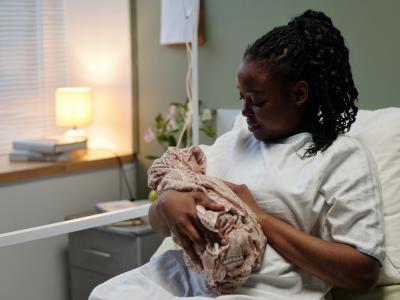Our weekly wrap-up of antimicrobial stewardship & antimicrobial resistance scans
New C difficile guidelines favor fidaxomicin over vancomycin
Guidelines published yesterday by the Infectious Diseases Society of America (IDSA) and the Society for Healthcare Epidemiology of America (SHEA) contain three new recommendations for treating adults who have Clostridioides difficile infection (CDI).
For both initial and recurring CDI cases, the new guidelines, published in Clinical Infectious Diseases, now recommend using the antibiotic fidaxomicin rather than vancomycin, though in both cases vancomycin is considered an acceptable alternative.
The previous CDI guidelines, issued in 2018, recommended either drug for initial and recurrent CDI, but the authors of the new guidelines—a panel of US, UK, and Canadian experts—say a review of additional evidence from randomized controlled trials indicates fidaxomicin is now the preferred option, though the recommendation is conditional, with moderate and low certainty evidence. The panel also notes that the cost of fidaxomicin, which was approved by the Food and Drug Administration (FDA) in 2011, may be prohibitive without adequate insurance coverage.
The third new recommendation is that in patients who've had a recurrent CDI episode within the past 6 months or have other risk factors for recurrence, clinicians should use the monoclonal antibody bezlotoxumab in conjunction with standard-of-care (SOC) antibiotics, rather than SOC antibiotics alone. This recommendation is also conditional, with a very low certainty of evidence, and the panel notes that the FDA warns against using bezlotoxumab in patients with congestive heart failure unless the benefit outweighs the risk.
The previous recommendation of fecal microbiota transplantation (FMT) in patients who have had several bouts of CDI and have failed appropriate antibiotic treatment remains unchanged, although the authors point out that the FDA has issued three warnings on FMT since 2018. The warnings concern the potential for transmission of pathogenic bacteria and SARS-CoV-2.
CDI is the leading cause of diarrhea in hospitals and one of the most common healthcare-associated infections. The Centers for Disease Control and Prevention estimates that 461,000 cases occur annually in the United States.
Jun 24 Clin Infect Dis abstract
Trial: 7 days of doxycycline preferable to azithromycin for rectal chlamydia
The results of a randomized clinical trial conducted in Australia indicate a 7-day course of doxycycline is superior to single-dose azithromycin for treating rectal chlamydia in men who have sex with men, researchers reported yesterday in the New England Journal of Medicine.
The double-blind, randomized trial was conducted at five sexual health clinics in Australia from August 2016 through August 2019 to determine which of the two regimens, which are both recommended for treatment of rectal chlamydia, is more efficacious.
While single-dose azithromycin has been an attractive therapy because of its simplicity, recent observational data has indicated that 7 days of doxycycline may be up to 20% more effective. But no randomized trials to date have been conducted. Enrollment in the trial was limited to asymptomatic chlamydia because more than 85% of rectal chlamydia infections among men who have sex with men are asymptomatic.
A total of 625 men were enrolled in the trial, and primary outcome data were available for 290 in the doxycycline group and 297 in the azithromycin group. In the modified intention-to-treat population, microbiologic cure occurred in 96.9% of men in the doxycycline group and 76.4% of men in the azithromycin group, for an adjusted risk difference of 19.9 percentage points. In the per-protocol population, microbiologic cure was observed in 95.7% of men in the doxycycline group and 73.3% in the azithromycin group, for an adjusted risk difference of 21.3 percentage points. Adverse events, including nausea, diarrhea, and vomiting, were reported in 33.8% of men in the doxycycline group and 45.1% in the azithromycin group.
The study authors say azithromycin will still have a place for the treatment of chlamydia during pregnancy, when doxycycline is not recommended, and in patients who are allergic to doxycycline.
Jun 24 N Engl J Med abstract
Resistant bacteria in veterinary workers linked to contact with animals
Nearly 1 in 10 veterinary workers in the Netherlands carries a multidrug-resistant strain of intestinal bacteria, almost twice the prevalence of the general population, Dutch researchers reported in a study being presented at the European Congress of Clinical Microbiology and Infectious Diseases (ECCMID).
To get a better understanding of the extent of transmission of intestinal bacteria carrying extended-spectrum beta-lactamase (ESBL) and AmpC genes between humans and animals, researchers from the National Institute for Public Health and the Environment collected stool samples from 482 veterinary workers and conducted whole-genome sequencing to identify the species of bacteria and detect the presence of ESBL/AmpC. They also analyzed questionnaires filled out by veterinary staff on their contact with animals at work and home, health status, and travel history to identify other risk factors.
The analysis found that 47 of 482 (9.8%) veterinary workers were colonized with at least one ESBL/AmpC-producing Enterobacterales. The most common ESBL genes detected were blaCTX-M-15 (26 samples), blaCTX-M-14 (7 samples), and blaDHA-1 (4 samples). The most common Escherichia coli strain identified was ST131, a frequent cause of human urinary tract infections. In addition, 16 of 33 (48.5%) who tested positive did so again 6 months later, and in 14 of those vet workers the same ESBL gene and E coli strain was identified. The analysis also found that 17% of household members of the participants carried ESBL-producing bacteria.
Among the risk factors identified was travel to Asia, Africa, and Latin America, along with reported stomach/bowel problems in the previous 4 weeks, but the study authors say those risk don't fully account for the presence of ESBL/AmpC-producing bacteria.
"So it seems highly likely that occupational contact with animals in the animal healthcare setting can provide a reservoir for ESBL-producing bacteria, despite the absence of specific occupational risk factors, such as contact with specific animal species," lead study author Anouk Meijs, MSc, said in an ECCMID press release.
The authors note that the observational study does not prove that close contact with animals was responsible for colonization with ESBL-producing bacteria.
ECCMID is being held online this year from Jul 9 through Jul 12.
Jun 23 ECCMID press release
Turkish hospital study shows benefits of antifungal stewardship
Originally published by CIDRAP News Jun 22
Implementing daily, pharmacist-driven antifungal stewardship activities at a tertiary care hospital in Turkey was associated with significant improvements in the appropriateness of antifungal therapy, Turkish researchers reported yesterday in Antimicrobial Agents and Chemotherapy.
The researchers evaluated and compared antifungal therapy at the hospital during three different periods. In the observation period, they evaluated the use of systemic antifungals for baseline measurement of appropriateness. In the second period, pharmacists organized monthly meetings to provide feedback and education on antifungal therapy to physicians. In the third period, pharmacists participated in daily ward rounds to evaluate appropriateness of antifungal therapy and make recommendations.
During the three periods, 105, 109, and 204 episodes of antifungal therapy, respectively, were assessed. During the third period, 157 recommendations were made and 151 (96.2%) were accepted.
The overall appropriateness of antifungal use increased significantly in the third period compared with the first two, with improvements observed in antifungal drug choice, dosage, and duration of therapy. Statistically significant increases were detected for antifungal prophylaxis (30.8%, 17.9%, and 46.3% in the three periods, respectively) and treatment of fungal disease (27.8%, 32.4%, 71.9%). Thirty-day mortality was not significantly changed between the three periods (19%, 15.6%, and 27.5%), but the authors note that was likely the result of the COVID-19 outbreak, which occurred during the third period and was accompanied by a high rate of patients with severe comorbidities.
"Considering the workload and variety of patients encountered in ward rounds, a team-based evaluation of fungal infections, including feedback and support from a clinical pharmacist, may help to increase the quality of antifungal therapies," the study authors wrote.
Jun 21 Antimicrob Agents Chemother abstract
Plunge in respiratory viruses, outpatient antibiotics during pandemic
Originally published by CIDRAP News Jun 21
Respiratory virus detections and ambulatory antibiotic prescribing rates for respiratory tract infections (RTIs) fell dramatically during the pandemic compared with previous years, a finding that could have implications for future antibiotic stewardship and public health strategies, researchers from the University of Wisconsin reported today in JAMA Internal Medicine.
Using surveillance data from the Wisconsin State Laboratory of Hygiene and antibiotic prescribing data from University of Wisconsin Health, the researchers compared the pre–COVID-19 pandemic period (July 2018 to February 2020) to a period covering several waves of COVID-19 activity (April 2020 to February 2021).
They found that respiratory virus detections demonstrated seasonal variation during the pre-pandemic period but not during the pandemic period, and that detections of winter seasonal viruses (influenza, respiratory syncytial virus, and seasonal coronavirus) fell from an average of 4,800 per month to 12 per month. Other respiratory virus detections fell from 560 per month pre-pandemic to 228 per month during the pandemic.
Adjusting for seasonality, monthly antibiotic prescriptions for RTIs fell 79%, from 10.5 to 2.2 prescriptions per 1,000 patient encounters. Non-influenza virus detections demonstrated the strongest correlation with antibiotic prescribing for RTI.
"The data suggest that COVID-19 transmission mitigation strategies may help curb respiratory viral diseases beyond SARS-CoV-2 and, indirectly, decrease antibiotic prescribing," the study authors wrote. "Notably, during COVID-19 surges in Wisconsin (October to December 2020), we did not observe increased ambulatory antibiotic prescriptions."
In addition to the reduced detection of viruses, the authors hypothesize highly accessible, rapid tests for SARS-CoV-2 and influenza may have helped avert unnecessary antibiotic prescriptions.
Jun 21 JAMA Internal Med study
US analysis finds rising multidrug-resistance in urinary E coli
Originally published by CIDRAP News Jun 21
An analysis of E coli isolated from US urinary cultures indicates concerning levels of resistance to first-line antibiotics, along with rising levels of multidrug resistance, researchers reported late last week in Clinical Infectious Diseases.
Using E coli isolates from female urine cultures collected at US outpatient facilities from 2011 through 2019, the researchers analyzed susceptibility to nitrofurantoin, trimethoprim-sulfamethoxazole (TMP-SMX), and fluoroquinolones, and assessed for extended-spectrum beta-lactamase production (ESBL+) and resistance to multiple antibiotic classes. Overall, more than 1.5 million non-duplicate E coli isolates from 295 outpatient facilities were included in the primary analysis, making it the largest published sample of E coli isolated US outpatient urine cultures.
The overall prevalence of E coli that were not-susceptible to TMP-SMX, fluoroquinolones, and nitrofurantoin was 25.4%, 21.1%, and 3.8%, respectively. ESBL+ was found in 6.4% of isolates, while 14.4% were not susceptible to two or more antibiotics and 3.8% were resistant to three or more. The highest overall prevalence for most not-susceptible phenotypes was in the East South Central census region, and the lowest prevalence was consistently found in the New England region, analysis showed.
Over the 9 years studied, the ESBL+ rate increased every year (except 2018), beginning at 4.1% and increasing to 7.3%. The prevalence of TMP-SMX resistance was consistently 25% or greater, while fluoroquinolone resistance declined from 21.9% to 20.3%, but was consistently over 20%. Modelling demonstrated a relative average yearly increase of 7.7% for ESBL+ isolates and 2.7% for isolates resistant to three or more antibiotics.
The study authors say the findings are concerning because resistance rates higher than 20% and rising levels of multidrug-resistance limit the empiric therapy options for treatment of uncomplicated urinary tract infections (UTIs), and will likely create a greater burden on emergency departments and acute care settings.
"Raising awareness of current regional patterns of not-susceptible E. coli isolates from outpatient UTIs can help to guide empiric treatment decisions of physicians and demonstrate the need for both antimicrobial stewardship efforts in outpatient settings, as well as new oral antibiotics to address the growing prevalence of resistant E. coli in the US," they wrote.
Jun 18 Clin Infect Dis abstract
Prescribing in Scottish COVID-19 patients highlights need for stewardship
Originally published by CIDRAP News Jun 21
Antibiotic prescribing for suspected RTIs was commonly observed among COVID-19 patients in Scottish hospitals during the first wave of the pandemic, Scottish researchers reported last week in JAC-Antimicrobial Resistance.
The findings from a point prevalence survey (PPS) conducted in designated COVID-19 wards of 15 Scottish hospitals from Apr 20 to 30, 2020, show that of 820 patients surveyed, 33.3% received at least one antibiotic for suspected RTI on the survey day, and 58.8% tested positive for SARS-CoV-2. Antibiotics were empirical in 91.9% of patients, and amoxicillin (24.6%), doxycycline (20.5%), and co-amoxiclav (15%)—the antibiotics recommended in local guidelines for RTI—were most frequently prescribed.
Multivariable logistic regression analysis revealed that antibiotic prescribing for RTIs was independently and positively associated with COPD/chronic lung disease, purulent/bloody sputum, abnormal chest x-ray, and a C-reactive protein value of 100 milligrams per liter or higher. Probable and definite hospital-acquired COVID-19 and diabetes were associated with lower odds of receiving an antibiotic for RTI.
"The rates of observed empirical antibiotic prescribing for RTI highlights the importance of ongoing local and national initiatives to reinforce stewardship in the COVID-19 context and beyond," the study authors wrote. "Clinical review and decision making, and early use of microbiological diagnostics, are central to limit unnecessary antibiotic therapy and other antibiotic-related harm."
Jun 18 JAC-Antimicrob Resist study














